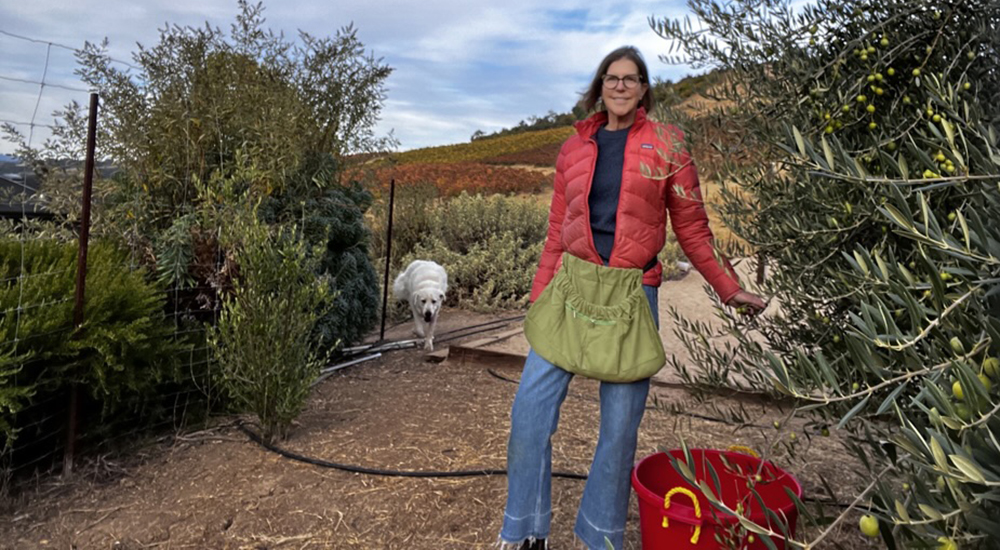
What's Next In the Gardens?
By JoAnn Cherry.
We grow more than grapes here at the MAHA. Tomatoes and chilis came in strong, but not until late September. In fact, Cris and I just finished “putting up” tomatoes from our home garden a week ago. We spent several days blanching, peeling, seeding, and canning. It becomes a meditative process that is somewhat enjoyable and saves us from the guilt of leaving tomatoes on the vine to rot. We are still drying and pickling peppers for salsa and are trying to figure out what to do with all of our eggplant. In addition to our home garden, we had a beautiful and prolific garden at the winery, tended by Lindsay, Lupe, and Oliver, all of whom did their own pickling, canning, and preserving. Having a winery full of produce that our employees can enjoy is a special thing. We've all enjoyed tasting each other's garden creations. Lupe’s wife sent a batch of pickled carrots and onions from our garden that is spectacular. I made an Italian pickled eggplant with Jimmy Nardello chili compote, garlic, and herbs. Oliver’s lactic pickles were delicious. Recipes to come.
The grapes, tomatoes, chilis, and eggplant were late, but our olives ripened at the usual time, which is early November. We picked and started the curing process on Nov 10 and pressed for oil on the 11th. Only about a week later than normal. We have several varieties of olives. We have about 100 Arbequina trees in the young orchard below the winery. Once these get going, we will have a nice supply of oil to share with our club members. Surrounding the party pad, we grow Lucques and Picholine, which are really nice oil olives but also great for curing. I like to do a salt brine cure or a lactic cure. Both result in delicious eating olives. We usually leave a tree unpicked to ripen to the point where the olives are starting to shrivel. These get treated to a dry salt cure resulting in sweet and salty prune-like olives that are delicious.
Interestingly, apples were on a relatively normal ripening path this year. Our five apple trees produce a huge crop every year. In fact, we usually have more apples than we know what to do with. One saving grace is that each variety ripens at a different time. We have an early ripener whose apples we start enjoying late spring. The Golden Delicious tree produces from July to September. Our Calville Blanc D’hiver is the Tart Tatin apple of France. This beauty is usually ready to pick late September. The Hauer Pippins are always very late ripeners. We just picked the last of them for cider, but they could have used another month on the tree if frost wasn’t imminent. What do we do with all these apples? My dad loves anything apple, so I always make a large batch or two of apple butter, which he consumes by the spoonful. Inspired by a New York Times article written by Eric Asimov, I used our bumper crop of apples to make hard cider fermented with Grenache grapes. So far, it’s tasting delicious with a few brix left to ferment. I plan to dose it with fresh apple juice before bottling to get a mild frisante. This is a project I have been wanting to undertake for years, so it’s exciting that it’s actually happening. In addition to apple butter and cider, I made chutney with green tomatoes, which was great with the Thanksgiving turkey, and I plan to can some apples for pie filling.
As for the vegetable gardens, we will cover our summer growing plots with the spent plants, leaving the roots in the ground for additional organic matter for the microbes to feed on. We will top these spent plants with compost, leaves and other garden cuttings and let the rows lay fallow and decomposing until springtime. Rows that were not used the summer will be seeded with shelling peas and sweet peas. We will mix compost into our super bags and plant lettuces, beets, carrots, and garlic. Root veggies are safe from our gophers and ground squirrels when planted in these bags. We will start seeds indoors for our spring crops like broccoli and cauliflower. Like the vineyard, our veggie gardens are farmed regeneratively.

